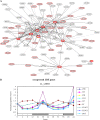Cytochrome P450 monooxygenases as reporters for circadian-regulated pathways
- PMID: 19386812
- PMCID: PMC2689971
- DOI: 10.1104/pp.108.130757
Cytochrome P450 monooxygenases as reporters for circadian-regulated pathways
Abstract
Cytochrome P450 monooxygenases (P450s) play important roles in the synthesis of diverse secondary compounds in Arabidopsis (Arabidopsis thaliana). Comparison of four data sets analyzing seedlings harvested over a 2-d period of constant conditions after growth with varying photoperiods and thermocycles recorded a total of 98 P450 loci as circadian regulated for at least one of the four conditions. Here, we further describe the circadian-regulated pathways using, as reporters, individual P450 loci that are likely to be rate limiting in secondary metabolic pathways. Reverse transcription-polymerase chain reaction gel blot analyses have confirmed circadian regulation of P450s in phenylpropanoid, carotenoid, oxylipin, glucosinolate, and brassinosteroid biosyntheses and have shown that both P450 and non-P450 genes in the many branches of the phenylpropanoid pathway have similar circadian patterns of expression. In silico analyses of the subsets of coregulated promoters have identified overrepresented promoter elements in various biosynthetic pathway genes, including MYB and MYB4 elements that are significantly more abundant in promoters for the core and lignin sections of phenylpropanoid metabolism. Interactions with these elements important for circadian regulation do not involve the MYB transcription factor PAP1, as previously proposed, since the expression patterns of circadian-regulated P450s are the same in pap1-D mutant seedlings as in wild-type seedlings. Further analysis of circadian-regulated promoters in other biochemical pathways provides us with the opportunity to identify novel promoter motifs that might be important in P450 circadian regulation.
Figures








Similar articles
-
Global profiling of rice and poplar transcriptomes highlights key conserved circadian-controlled pathways and cis-regulatory modules.PLoS One. 2011;6(6):e16907. doi: 10.1371/journal.pone.0016907. Epub 2011 Jun 9. PLoS One. 2011. PMID: 21694767 Free PMC article.
-
Whole genome co-expression analysis of soybean cytochrome P450 genes identifies nodulation-specific P450 monooxygenases.BMC Plant Biol. 2010 Nov 9;10:243. doi: 10.1186/1471-2229-10-243. BMC Plant Biol. 2010. PMID: 21062474 Free PMC article.
-
An extensive (co-)expression analysis tool for the cytochrome P450 superfamily in Arabidopsis thaliana.BMC Plant Biol. 2008 Apr 23;8:47. doi: 10.1186/1471-2229-8-47. BMC Plant Biol. 2008. PMID: 18433503 Free PMC article.
-
Functional genomics of P450s.Annu Rev Plant Biol. 2003;54:629-67. doi: 10.1146/annurev.arplant.54.031902.134840. Annu Rev Plant Biol. 2003. PMID: 14503006 Review.
-
Cytochrome P450 and the biological clock in mammals.Curr Drug Metab. 2009 Feb;10(2):104-15. doi: 10.2174/138920009787522179. Curr Drug Metab. 2009. PMID: 19275546 Review.
Cited by
-
Abiotic stress and genome dynamics: specific genes and transposable elements response to iron excess in rice.Rice (N Y). 2015 Feb 25;8:13. doi: 10.1186/s12284-015-0045-6. eCollection 2015. Rice (N Y). 2015. PMID: 25844118 Free PMC article.
-
Overexpression of the PanaxginsengCYP703 Alters Cutin Composition of Reproductive Tissues in Arabidopsis.Plants (Basel). 2022 Jan 30;11(3):383. doi: 10.3390/plants11030383. Plants (Basel). 2022. PMID: 35161364 Free PMC article.
-
A mathematical model for strigolactone biosynthesis in plants.Front Plant Sci. 2022 Sep 2;13:979162. doi: 10.3389/fpls.2022.979162. eCollection 2022. Front Plant Sci. 2022. PMID: 36119618 Free PMC article.
-
CYP709B3, a cytochrome P450 monooxygenase gene involved in salt tolerance in Arabidopsis thaliana.BMC Plant Biol. 2013 Oct 28;13:169. doi: 10.1186/1471-2229-13-169. BMC Plant Biol. 2013. PMID: 24164720 Free PMC article.
-
Tissue specific diurnal rhythms of metabolites and their regulation during herbivore attack in a native tobacco, Nicotiana attenuata.PLoS One. 2011;6(10):e26214. doi: 10.1371/journal.pone.0026214. Epub 2011 Oct 18. PLoS One. 2011. PMID: 22028833 Free PMC article.
References
Publication types
MeSH terms
Substances
Grants and funding
LinkOut - more resources
Full Text Sources
Other Literature Sources
Molecular Biology Databases

